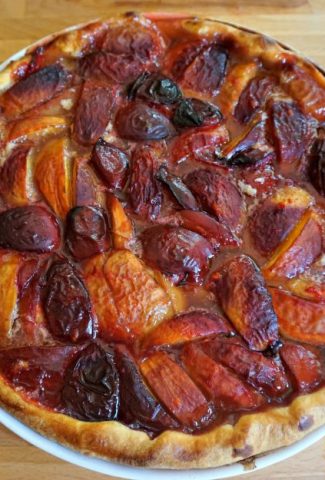
What fruit pie is your favorite in the summer?
Peach, Nectarine and Plum Pie has been my family’s favorite these past few years. We look forward to the moment when the peaches, nectarines and plums are at their freshest and fill up the grocer’s stalls at a reasonable price. This week that ideal moment finally arrived, just in time for my daughter’s birthday celebration.
I should confess that I have not actually waited until this week to make this wonderful pie. I’ve already been “practicing” for the past 10 days, bringing a pie to a friend’s house for dinner and making another for my family.
Love for baking pies
Making pies is probably my favorite baking activity. It’s a great way to appreciate seasonal fruit all year round. You can place the fruit in a special pattern or simply pour the fruit onto the pie crust. Both ways taste essentially the same. I usually save time by just pouring the fruit onto the pie crust, unless it’s a special occasion.
Pie Options
Pies allow you to use your creativity to make each pie different. I generally don’t plan ahead too much when making pies and let my inspiration guide me. For instance, you can use a single crust on the bottom, add a second crust on top, or use extra dough to place on top to decorate the pie.
You can also choose different kinds of crust, depending on the result you want. A lighter fruit pie (especially with fresh fruit on top of cream) can be delicious on a shortcake crust, while a heavier fruit pie needs the support of a pastry crust to keep the fruit and its juices inside. For a peach, nectarine and plum pie, my own pastry crust (pâte brisée) is perfect.
Trying a Peach, Nectarine and Plum Pie
So if you are “practicing” or preparing a pie for a special occasion, try a Peach, Nectarine and Plum Pie. This recipe can serve as a basis for making other fruit pies. As a general rule, for one pie I use a kilo (2.2 lbs) of fruit, up to one-third of this weight in sugar (depending on the fruit you may use about half of this amount), the juice of one lemon, 1 to 2 tablespoons of instant tapioca flour or cornstarch, and spices, such as cinnamon, allspice, cloves and/or nutmeg (depending on the fruit used).
Please share this recipe with your friends and write to me in the comments below about your favorite pie combinations.
Peach, Nectarine and Plum Pie
Ingredients
- 1 pastry crust
- 350 g peaches pitted
- 350 g nectarines pitted
- 350 g red plums pitted
- 200 g raw cane sugar or equivalent sugar
- lemon juice (juice of 1 lemon)
- 2 tbsp instant tapioca flour or cornstarch
- 1/2 tsp cinnamon (or more according to taste)
- 40 g butter
Instructions
- Gather all the ingredients. Wash all the fruit.
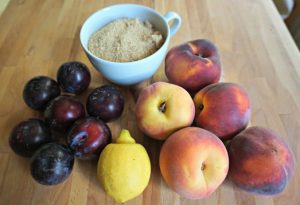
- Cut the fruit into sections and remove their pits. I usually cut the peaches and nectarines into 8 sections and the plums into 4 sections. I cut them as I would a pie: using a sharp knife and cutting vertically from top to bottom into sections. I then remove the sections away from the pits. However, you can also remove the pits and then cut into sections.
- Put all the fruit into a non-reactive bowl. Mix the tapioca flour or cornstarch with the sugar and add to fruit. Add seasoning and the lemon juice.
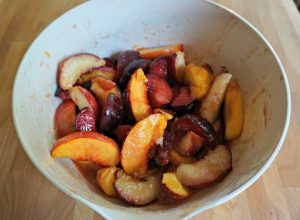
- Let the fruit sit about 15 minutes at least so the flavors mix a bit. During this time you can preheat the oven and roll out your dough.
- Preheat oven to 180°C / 350°F. When the dough is placed into your pie pan, fold over the top of the crust into your preferred pattern. I usually just crumple the dough using my forefinger and thumb going around the top edge. Make sure you prick the bottom of the pie crust several times. Brush the crust with egg white, as this will help prevent the liquid and fruit from making the crust soggy.
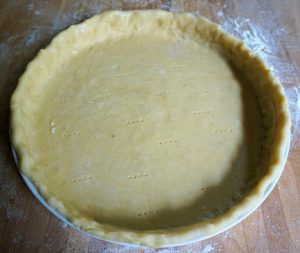
- Place the fruit into your pie tin. You can either do this in attractive manner by making a design or simply by pouring the fruit in. Either way, I usually fix the fruit a little so fruit is evenly placed around the pie and it looks as even as possible.
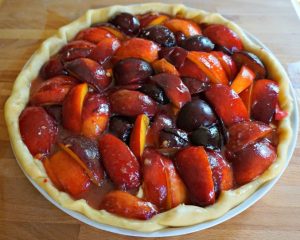
- Put little pieces of butter (fingertip size) randomly on top of the pie. If you prefer you can push them down a bit into the fruit.
- Place in the top half of the oven for approximately 45 minutes or until the crust is golden and the fruit looks cooked. I usually turn my pie half way and then gauge my time from how it looks at that moment. Sometimes if the crusts looks like it is browning too early, I will place at this time a sheet of foil loosely on top of the pie (not folded down onto the pie) to help prevent the crust from burning before the fruit filling is done.
- Remove the pie from the oven and let cool before serving. It can be served warm (not hot) with ice cream or at room temperature however you wish. The pie might be more liquidy if you serve it warm than if it is cooled completely.
Notes
- The weight of the fruit mentioned above is after the pits are removed.
- I recommend including the juice of 1 lemon with the fruit mixture as it helps bring out the flavor and offset the sweetness of the pie. The juice however can make the fruit mixture more liquidy. The fruit mixture will become more liquidy with time if you let the mixture sit longer than 15 minutes.
- When you place the fruit onto the unbaked pie crust there will be some liquid from the bowl that will come with the fruit. It is good to include some of the liquid with the fruit as it contains a lot of the sugar and the tapioca flour / cornstarch. However, I usually leave some of the extra juice (about 1/4 or 1/2 cup) in the bowl to avoid the pie from being too liquidy at the end.
- The amount of sugar and tapioca flour / cornstarch that you will need will depend on the fruit that you use. Some fruit are naturally higher in pectin (apples, for instance) so require less thickener than other fruits. The sugar is intended to bring out the flavor of the fruit and to offset some of the tartness of the fruit. The sugar also helps to create a thick syrup when the pie is baked and the juices from the fruit mixes with the sugar. Start off with about half of the sugar indicated and then add more until the taste is as you desire. If you use frozen fruit, do not thaw in advance, and add more sugar and thickener (tapioca flour / cornstarch) than if you use fresh fruit.


Leave a Reply